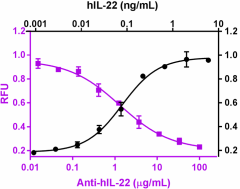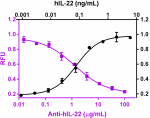- Clone
- A16057A (See other available formats)
- Regulatory Status
- RUO
- Other Names
- TIFa, IL-D110, IL-TIF, TIFIL-23, zcyto18
- Isotype
- Mouse IgG2a, κ
- Ave. Rating
- Submit a Review
- Product Citations
- publications

-

Recombinant human IL-22 (Black circles, Cat. No. 571306) stimulates the production of IL-10 in human Colo 205 cells. Anti-human IL-22 antibody (clone A16057A, purple squares) inhibits the effect of recombinant human IL-22 at 0.75 ng/mL in human Colo 205 cells in a dose-dependent manner. The ND50 = 1.2 - 6 μg/mL.
| Cat # | Size | Price | Quantity Check Availability | Save | ||
|---|---|---|---|---|---|---|
| 618303 | 100 µg | £185 | ||||
| 618304 | 1 mg | £490 | ||||
Select size of product is eligible for a 40% discount! Promotion valid until December 31, 2024. Exclusions apply. To view full promotion terms and conditions or to contact your local BioLegend representative to receive a quote, visit our webpage.
IL-22 is a cytokine structurally related to IL-10. Originally identified as a murine gene induced by IL-9 in T and mast cells, IL-22 was initially designated ILTIF (IL-10-related T cell-derived inducible factor). IL-22 belongs to a family of cytokines with limited homology to IL-10, namely IL-10, IL-19, IL-20, IL-24, IL-26, and the IFN-λs, IL-28A, IL-28B and IL-29. Human IL-22 shares 79% amino acid identity with murine IL-22 and 25% identity with human IL-10. IL-22 biological activity is initiated by binding to a cell surface complex composed of IL-22R1 and IL-10R2 receptor chains. Activity is further regulated through interactions with the soluble binding protein, IL-22BP, which shares sequence similarity with an extracellular region of IL-22R1 (sIL-22R1). Both chains of the IL-22R complex belong to the class II CRF. Two types of IL-22 binding receptors have been discovered, a membrane-bound receptor and a soluble receptor, both encoded by different genes. IL-22 is produced by Th17 cells and newly identified Th22 cells. It plays a critical role in mucosal immunity in addition to the deregulated inflammation observed in autoimmune diseases.
Product DetailsProduct Details
- Verified Reactivity
- Human
- Antibody Type
- Monoclonal
- Host Species
- Mouse
- Immunogen
- Recombinant Human IL-22
- Formulation
- 0.2 µm filtered in phosphate-buffered solution, pH 7.2, containing no preservative.
- Endotoxin Level
- Less than 0.01 EU/µg of the protein (< 0.001 ng/µg of the protein) as determined by the LAL test.
- Preparation
- The Ultra-LEAF™ (Low Endotoxin, Azide-Free) antibody was purified by affinity chromatography.
- Concentration
- The antibody is bottled at the concentration indicated on the vial, typically between 2 mg/mL and 3 mg/mL. Older lots may have also been bottled at 1 mg/mL. To obtain lot-specific concentration and expiration, please enter the lot number in our Certificate of Analysis online tool.
- Storage & Handling
- The antibody solution should be stored undiluted between 2°C and 8°C. This Ultra-LEAF™ solution contains no preservative; handle under aseptic conditions.
- Application
-
Neut - Quality tested
- Recommended Usage
-
Each lot of this antibody is quality control tested by the neutralization of IL-10 production induced by human recombinant IL-22 (0.75 ng/mL) on human Colo 205 cells. ND50 range: 1.2 - 6.0 µg/mL. It is recommended that the reagent be titrated for optimal performance for each application.
- RRID
-
AB_2814466 (BioLegend Cat. No. 618303)
AB_2814466 (BioLegend Cat. No. 618304)
Antigen Details
- Structure
- Cytokine
- Distribution
-
Thymic lymphomas, T cells, activated T cells, macrophages, and mast cells
- Function
- Enhances the production of acute phase proteins in a hepatocyte cell line, HepG2; Promotes Th17 cells to transmigrate through the blood-brain barrier in multiple sclerosis
- Interaction
- Interacts with a cell surface complex composed of IL-22R1 and IL-10R2 receptor chains which are expressed in epithelial cells of inflammatory diseases such as psoriasis, Crohn's disease, rheumatoid arthritis, or allergic asthma
- Ligand/Receptor
- IL-22R1 and IL-10R2 receptor chains
- Cell Type
- Epithelial cells, NK cells, T cells, Th17
- Biology Area
- Cell Biology, Immunology, Neuroinflammation, Stem Cells
- Molecular Family
- Cytokines/Chemokines
- Antigen References
-
- Nagalakshmi ML, et al. 2004. Intern Immunopharmacol. 4:679-691.
- Kebir H, et al. 2007. Nat Med. 13:1173-1175.
- Gu Y, et al. 2008. Eur J Immunol. 38:1807-1813.
- Pene J, et al. 2008. J Immunol. 180:7423-7430.
- Dumotier L, et al. 2000. J immune 164:1814-1819.
- Xie MH, et al. 2000. J Biol Chem. 765:31335-31339.
- Jones BC, et al. 2008. Structure. 16:1333-44
- Kotenko SV, et al. 2001. J Immunol. 166:7096-71033.
- Chang C, et al. 2006. Cell Res 16:902-907.
- Gene ID
- 50616 View all products for this Gene ID
- UniProt
- View information about IL-22 on UniProt.org
Related FAQs
- Do you guarantee that your antibodies are totally pathogen free?
-
BioLegend does not test for pathogens in-house aside from the GoInVivo™ product line. However, upon request, this can be tested on a custom basis with an outside, independent laboratory.
- Does BioLegend test each Ultra-LEAF™ antibody by functional assay?
-
No, BioLegend does not test Ultra-LEAF™ antibodies by functional assays unless otherwise indicated. Due to the possible complexities and variations of uses of biofunctional antibodies in different assays and because of the large product portfolio, BioLegend does not currently perform functional assays as a routine QC for the antibodies. However, we do provide references in which the antibodies were used for functional assays and we do perform QC to verify the specificity and quality of the antibody based on our strict specification criteria.
- Does BioLegend test each Ultra-LEAF™ antibody for potential pathogens?
-
No, BioLegend does not test for pathogens in-house unless otherwise indicated. However, we can recommend an outside vendor to perform this testing as needed.
- Have you tested this Ultra-LEAF™ antibody for in vivo or in vitro applications?
-
We don't test our antibodies for in vivo or in vitro applications unless otherwise indicated. Depending on the product, the TDS may describe literature supporting usage of a particular product for bioassay. It may be best to further consult the literature to find clone specific information.
Other Formats
View All IL-22 Reagents Request Custom Conjugation| Description | Clone | Applications |
|---|---|---|
| Ultra-LEAF™ Purified anti-human IL-22 | A16057A | Neut |
Compare Data Across All Formats
This data display is provided for general comparisons between formats.
Your actual data may vary due to variations in samples, target cells, instruments and their settings, staining conditions, and other factors.
If you need assistance with selecting the best format contact our expert technical support team.
-
Ultra-LEAF™ Purified anti-human IL-22

Recombinant human IL-22 (Black circles, Cat. No. 571306) sti...
 Login / Register
Login / Register 








Follow Us